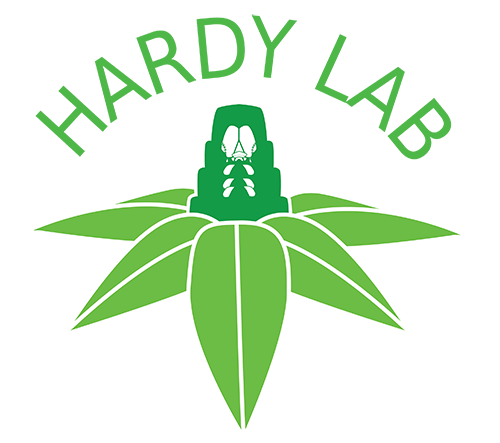Valid Names Results
Pelionella manifecta (Borchsenius, 1949) (Pseudococcidae: Pelionella)Nomenclatural History
- Peliococcus manifectus Borchsenius 1949: 245. Type data: AZERBAIJAN: Geok-Tapa and ARMENIA: Megri, on Chrysanthemum sp.. Lectotype, female, by subsequent designation (Danzig2001,125). Type depository: St. Petersburg: Zoological Museum, Academy of Science, Russia; accepted valid name
- Peliococcus albertaccius Goux 1990a: 83. Type data: FRANCE: Corsica, Albertacce, on Helichrysum sp.. Holotype, female, Type depository: Paris: Museum National d'Histoire naturelle, France; junior synonym (discovered by Kaydan2015, 234). Illustr.
- Pelionella manifecta Danzig & Gavrilovo-Zimin 2014: 457. unavailable name that is placed
- Pelionella manifecta Danzig & Gavrilovo-Zimin, 2014; Kaydan 2015. change of combination
Common Names
Ecological Associates
Hosts:
Families: 6 | Genera: 13
- Apiaceae
- Turgenia latifolia | UlgentErYa2022
- Asteraceae
- Ancathia igniaria | BenDov1994 Mateso1968
- Artemisia indica | Tanaka2018a
- Artemisia vulgaris | KaydanKo2010a
- Centaurea solstitialis | KaydanKiKo2005
- Chrysanthemum | BenDov1994 Borchs1949
- Cirsium arvense | BatsanKaKi2017
- Helichrysum | BenDov1994 Goux1990a Marott1992a
- Helichrysum litoreum | Kaydan2015 | (= Helichrysum angustifolium)
- Sonchus | KaydanKiKo2005
- Boraginaceae
- Echium | KaydanKiKo2005
- Echium angustifolium | YerlikBaKa2023
- Crassulaceae
- Sedum | SzitaFeBe2017
- Euphorbiaceae
- Euphorbia | UlgentErYa2022
- Lamiaceae
- Mentha | YerlikBaKa2023
- Thymus | Danzig2001
Geographic Distribution
Countries: 13
- Armenia | BenDov1994 Borchs1949
- Azerbaijan | BenDov1994 Borchs1949
- Corsica | BenDov1994 Foldi2001 Foldi2003 Goux1990a
- France | Kaydan2015
- Greece | SzitaFeBe2017
- Italy | BenDov1994 LongoMaPe1995 Marott1992a Pelliz2003
- Japan | Tanaka2018a
- Kazakhstan | BenDov1994 Mateso1968
- Poland | LagowsGo2020
- Russia | Kaydan2015
- Sardinia | Pelliz2011
- Sweden | BenDov1994 Gertss2001 Ossian1959
- Turkey | KaydanKiKo2005 KaydanKoYa2001 KaydanUlEr2007
Keys
- Tanaka2018a: pp.56-57 ( Adult (F) ) [Pelionella]
- DanzigGa2014: pp.450-451 ( Adult (F) ) [Palaearctic Pelionella species]
- Danzig2001: pp.124-125 ( Adult (F) ) [Palaearctic region] Key as: Peliococcus manifectus
- Tang1992: pp.513 ( Adult (F) ) [China]
- TerGri1973: pp.176 ( Adult (F) ) [Armenia] Key as: Peliococcus manifectus
- Borchs1949: pp.242 ( Adult (F) ) [Palaearctic region] Key as: Peliococcus manifectus
Remarks
- Systematics: Danzig & Gavrilov-Zimin (2014) used the name "Pelionella manifecta" before the genus name was made available in Kaydan, 2015. Danzig & Gavrilov-Zimin (2014) listed Pelionella manifecta without citing "Kaydan 2014?" (due to a typographical error) and without suggesting that this was a new combination. Kaydan, 2015 made the name available in a manner that satisfied the requirements on the Code (ICZN, 1999).
Pelionella manifecta is most similar to P. multipora in having: (i) dorsal clusters with multilocular disc pores, (ii) 18 pairs of marginal cerarii, and (iii) 2 sizes of oral collar tubular ducts on the dorsum. However, P. manifecta differs from P. multipora in having 2-6 multilocular disc pores in each cluster (5-16 pores in P. multipora). P. manifecta is also similar to P. balteata and P. cycliger in having multilocular disc pores in clusters, but differs from both of these species in having 2 sizes of oral collar tubular duct in each cluster. There are some differences between the French and Azerbaijan specimens, namely: (i) number of clusters on dorsum (fewer in Azerbaijan population); (ii) number of clusters on midventer (fewer in Azerbaijan population); (iii) shape and number of cerarian setae (three cerarian setae on C3 in French population, two cerarian setae on C3 in Azerbaijan population); and (iv) number of trilocular pores in mid-venter (fewer in Azerbaijan population). Nonetheless, it is considered that these differences represent geographical variation. (Kaydan, 2015) The Japanese population of P. manifecta is morphologically slightly different from the Azerbaijani and French populations in lacking large-type oral-collar tubular ducts associated with clusters formed by multilocular pores and oral-collar ducts on ventral abdominal segments III and IV. (Tanaka, 2018a)
- Structure: Adult female body elongate oval, 1.36–1.88 mm long, 0.86–1.10 mm wide. Eyes marginal, 47.5–60.0 µm wide. Antenna 9 segmented.
- General Remarks: Good description and illustration of the adult female given by Ter-Grigorian (1973), Marotta (1992a) and by Danzig (2001). Good description of the adult female given by Borchsenius (1949) and by Tang (1992).Good description and illustration of the adult female given by Goux (1990a).
Illustrations
Citations
- BatsanKaKi2017: distribution, host, 264
- BenDov1994: catalog, 291, 294-295
- Borchs1949: description, distribution, host, illustration, taxonomy, 245-246
- BugajNJuKa2021: distribution, list, 309
- CebeciAr2006: distribution, host, 139
- Danzig2001: description, distribution, host, illustration, taxonomy, 125, 127
- DanzigGa2014: description, distribution, host, illustration, key, taxonomy, 457-460
- Foldi2001: distribution, 303-308
- Foldi2003: distribution, host, 148
- FoldiGe2018: distribution, list, 12
- Gertss2001: distribution, 123-130
- Goux1990a: description, distribution, host, illustration, taxonomy, 83-86
- KaydanKiKo2005: distribution, host, 89
- KaydanKo2010a: distribution, host, 35
- KaydanKoYa2001: distribution, host, 380
- KaydanUlEr2007: catalog, distribution, host, 100
- LagowsGo2020: distribution, 70
- LongoMaPe1995: distribution, 119
- Marott1992a: description, distribution, host, illustration, taxonomy, 80-82
- Mateso1968: distribution, host, 111
- Ossian1959: distribution, host, 195
- Pelliz2003: distribution, host, 100
- Pelliz2011: distribution, 313
- SzitaFeBe2017: distribution, host, 473
- Tanaka2018a: description, distribution, illustration, key, morphology, taxonomy, 49-53
- Tanaka2018a: karyology, 56-57
- Tang1992: description, distribution, host, taxonomy, 518-519
- TerGri1973: description, distribution, host, illustration, taxonomy, 177-179
- UlgentErYa2022: distribution, host, S124
- WilliaDe2020: taxonomy, 199
- YerlikBaKa2023: distribution, host, illustration, list, 3, 5


